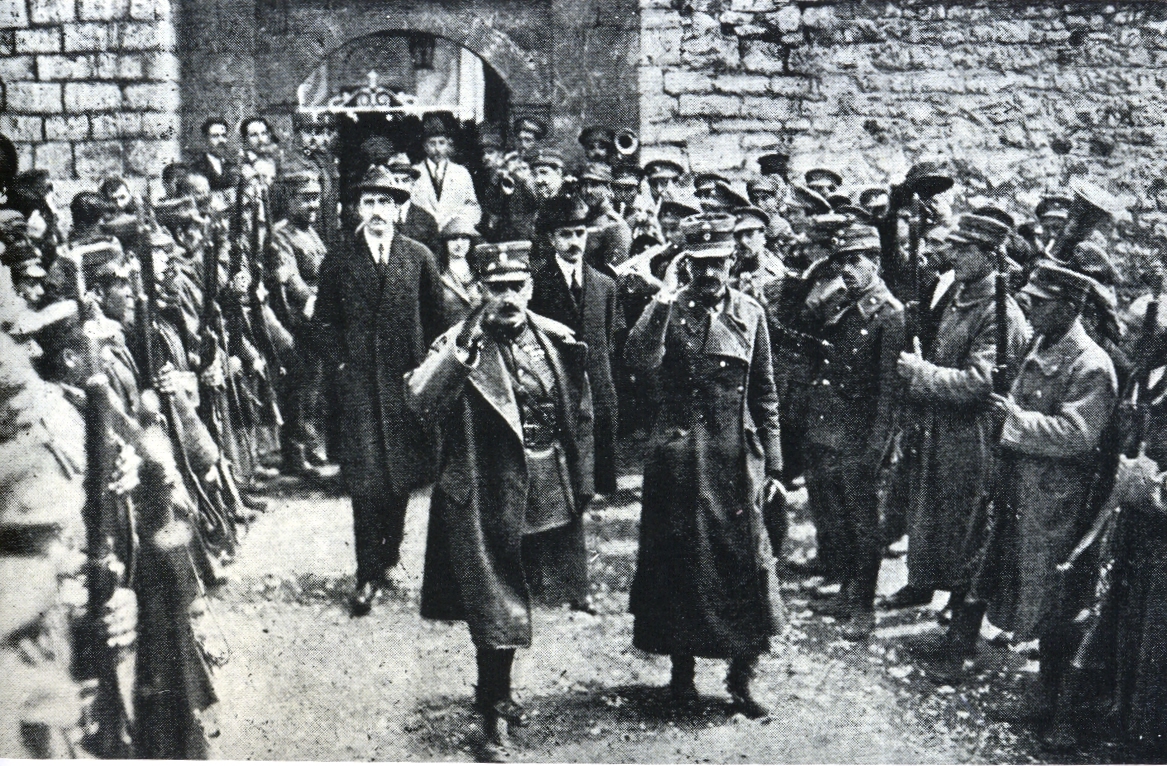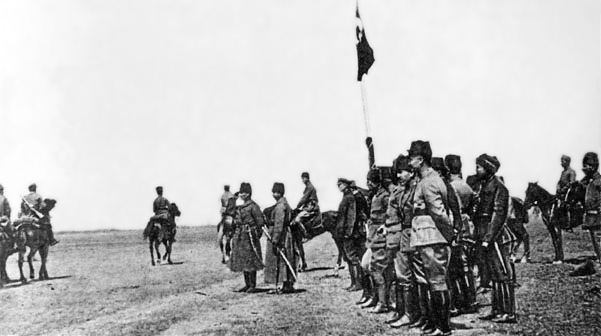|
21st Brigade (Greece)
The 1st Infantry Regiment "Sangarios" ( el, 1ο Σύνταγμα Πεζικού «ΣΑΓΓΑΡΙΟΣ», 1ο ΣΠ) is a motorized infantry regiment of the Hellenic Army. Established in 1885 at Athens, it fought in all conflicts in which Greece participated until World War II, when it was disbanded following the German invasion of Greece. It was re-established as the 21st Brigade (21η Ταξιαρχία) in 1945, and participated in the Greek Civil War. Receiving the designation 1st Infantry Regiment again in 1951, it was headquartered in Florina from 1952 until its disbandment in 1998. In 2013 it was re-established at Florina. History From the establishment of the Hellenic Army until the 1880s, the largest units created were battalions, due to the small extent of the Kingdom of Greece and the small size of its army. Only following the annexation of Thessaly in 1881 did both expand enough to warrant the establishment of regimental-sized units, and on 26 June 1885, by royal decree, t ... [...More Info...] [...Related Items...] OR: [Wikipedia] [Google] [Baidu] |
Motorized Infantry
Motorized infantry is infantry that is transported by trucks or other motor vehicles. It is distinguished from mechanized infantry, which is carried in armoured personnel carriers or infantry fighting vehicles, and from light infantry, which can typically operate autonomously from supporting elements and vehicles for relatively long periods and may be airborne. Operations As defined by the United States Army, motorization is "the use of unarmored wheeled vehicles for the transportation of combat units."Infantry Division Transportation Battalion and Transportation, Tactical Carrier Units. (1962). United States: Headquarters, Department of the Army. p. 11 Motorizing infantry is the first stage towards the mechanization of an army. Civilian trucks are often readily adaptable to military uses of transporting soldiers, towing guns, and carrying equipment and supplies. Motorization greatly increases the strategic mobility of infantry units, which would otherwise rely ... [...More Info...] [...Related Items...] OR: [Wikipedia] [Google] [Baidu] |
World War I
World War I (28 July 1914 11 November 1918), often abbreviated as WWI, was one of the deadliest global conflicts in history. Belligerents included much of Europe, the Russian Empire, the United States, and the Ottoman Empire, with fighting occurring throughout Europe, the Middle East, Africa, the Pacific, and parts of Asia. An estimated 9 million soldiers were killed in combat, plus another 23 million wounded, while 5 million civilians died as a result of military action, hunger, and disease. Millions more died in genocides within the Ottoman Empire and in the 1918 influenza pandemic, which was exacerbated by the movement of combatants during the war. Prior to 1914, the European great powers were divided between the Triple Entente (comprising France, Russia, and Britain) and the Triple Alliance (containing Germany, Austria-Hungary, and Italy). Tensions in the Balkans came to a head on 28 June 1914, following the assassination of Archduke Franz Ferdin ... [...More Info...] [...Related Items...] OR: [Wikipedia] [Google] [Baidu] |
11 September 1922 Revolution
The 11 September 1922 Revolution ( el, Επανάσταση της 11ης Σεπτεμβρίου 1922) was an uprising by the Greek army and navy against the government in Athens. The revolution took place on 24 September 1922, although the date was "11 September" on the Julian calendar still in use at the time in Greece. History The Greek Army had just been defeated in the Asia Minor Campaign and had been evacuated from Anatolia to the Greek islands in the eastern Aegean. Discontent among the middle-ranking officers and men for the campaign's conduct by the royal government boiled over into armed revolt led by pro-Venizelist and anti-royalist officers. The mutiny spread quickly and seized power in Athens, forcing King Constantine I to abdicate and leave the country, with a military government ruling the country until early 1924, shortly before the Greek monarchy was abolished and the Second Hellenic Republic established. The defeat of the Greek forces in Anatolia had alarmed ... [...More Info...] [...Related Items...] OR: [Wikipedia] [Google] [Baidu] |
Battle Of Dumlupınar
The Battle of Dumlupınar ( el, Μάχη του Τουμλού Μπουνάρ, translit=Máchi tou Toumloú Bounár, tr, Dumlupınar (Meydan) Muharebesi, lit=Dumlupınar (Field) Battle), or known as Field Battle of the Commander-in-Chief ( tr, Başkumandanlık Meydan Muharebesi) in Turkey, was the last battle in the Greco-Turkish War (1919–1922) (part of the Turkish War of Independence). The battle was fought from 26 to 30 August 1922 near Dumlupınar, Kütahya in Turkey. Background Following the attrition battle on the Sakarya River (Battle of Sakarya) in August–September 1921, the Greek Army of Asia Minor under General Anastasios Papoulas retreated to a defensive line extending from the town of Izmit (ancient Nicomedia) to the towns of Eskişehir and Kara Hisâr-ı Sahib (present-day Afyonkarahisar). The Greek line formed a 700 km arc stretching in a north–south direction along difficult hilly ground with high hills, called ''tepes'', rising out of broken ter ... [...More Info...] [...Related Items...] OR: [Wikipedia] [Google] [Baidu] |
Great Offensive
The Great Offensive ( tr, Büyük Taarruz; ) was the largest and final military operation of the Turkish War of Independence, fought between the Turkish Armed Forces loyal to the government of the Grand National Assembly of Turkey, and the Kingdom of Greece, ending the Greco-Turkish War. The offensive began on 26 August 1922 with the Battle of Dumlupınar. The Turks amassed around 98,000 men, the largest number since the beginning of the war, to begin the offensive against the Greek army of approximately 130,000 men.International Committee of Historical Sciences, 1980page 227 From 31 August to 9 September, the front moved a distance of as the Greek troops retreated. The Turkish army lacked motorized vehicles; its forces consisted of infantry and cavalry units, and logistical support was provided by a supply system based on ox carts. The Turkish troops reached the sea on 9 September with the capture of İzmir. The operation ended on 18 September 1922 with the capture of Erde ... [...More Info...] [...Related Items...] OR: [Wikipedia] [Google] [Baidu] |
Battle Of The Sakarya
The Battle of the Sakarya ( tr, Sakarya Meydan Muharebesi, lit=Sakarya Field Battle), also known as the Battle of the Sangarios ( el, Μάχη του Σαγγαρίου, Máchi tou Sangaríou), was an important engagement in the Greco-Turkish War (1919–1922). The battle went on for 21 days from August 23 to September 13, 1921, close to the banks of the Sakarya River in the immediate vicinity of Polatlı, which is today a district of the Ankara Province. The battle line stretched over 62 miles (100 km). It is also known as the Officers' Battle ( tr, Subaylar Savaşı) in Turkey because of the unusually high casualty rate (70–80%) among the officers. Later, it was also called '' Melhâme-i Kübrâ'' (Islamic equivalent to Armageddon) by Kemal Atatürk. The Battle of the Sakarya is considered as the turning point of the Turkish War of Independence. The Turkish observer, writer, and literary critic İsmail Habip Sevük later described the importance of the battle with thes ... [...More Info...] [...Related Items...] OR: [Wikipedia] [Google] [Baidu] |
Battle Of Kütahya–Eskişehir
The Battle of Kütahya–Eskişehir ( el, Μάχες Κιουτάχειας-Εσκί Σεχίρ (Δορυλαίου), tr, Kütahya-Eskişehir Muharebeleri), was fought between July 10 and July 24 (or June 27 and July 10 in the old calendar, then in use in Greece), 1921 when the Greek Army of Asia Minor clashed with the Turkish troops commanded by İsmet Pasha in defence of the line of Kara Hisâr-ı Sahib (present day Afyonkarahisar)-Kütahya-Eskişehir. It was also known in some Greek historiography as the Battles of Kutahya-Dorylaion and known in Turkish historiography as the Battles of Kütahya-Eskişehir ( tr, Kütahya-Eskişehir Muharebeleri or ). It was part of the Greek Asia Minor Campaign and the Turkish War of Independence of 1919–1922. Strategically, the battle was of little importance as the Greeks failed to grasp the opportunity to encircle the retreating Turkish troops. This proved later to be a major strategic error, when the two sides had to meet each other a ... [...More Info...] [...Related Items...] OR: [Wikipedia] [Google] [Baidu] |
Second Battle Of İnönü
The Second Battle of İnönü ( tr, İkinci İnönü Muharebesi) was a battle fought between March 23 and April 1, 1921 near İnönü in present-day Eskişehir Province, Turkey during the Greco-Turkish War (1919–22), also known as the western front of the larger Turkish War of Independence. It marked a turning point in the Greco-Turkish War and the Turkish War of Independence of which it was a part, as Greek forces had previously been victorious over mostly irregular Turkish forces and suffered their first major halt in Asia minor campaign. Background After the First Battle of İnönü, where Miralay (Colonel) İsmet Bey fought against a Greek detachment out of occupied Bursa, the Greeks prepared for another attack aiming the towns of Eskisehir and Afyonkarahisar with their inter-connecting rail-lines. Ptolemaios Sarigiannis, staff officer in the Army of Asia Minor, made the offensive plan. Meanwhile, the London Conference was held between February 21 and March 11, 19 ... [...More Info...] [...Related Items...] OR: [Wikipedia] [Google] [Baidu] |
Greek Summer Offensive
The Greek Summer Offensive of 1920 was an offensive by the Greek army, assisted by British forces, to capture the southern region of the Sea of Marmara and the Aegean Region from the Kuva-yi Milliye (National Forces) of the provisional Turkish national movement government in Ankara. Additionally, the Greek and British forces were supported by the Kuva-yi Inzibatiye (Forces of Order) of the Ottoman government in Constantinople, which sought to crush the Turkish nationalist forces. The offensive was part of the Greco-Turkish War and was one of several engagements where British troops assisted the advancing Greek army. British troops actively took part in invading coastal towns of the Sea of Marmara. With the approval of the Allies, the Greeks started their offensive on 22 June 1920 and crossed the 'Milne Line'.Stanley Sandler: ''Ground Warfare: H-Q'', ABC-CLIO, 2002, , page 337. The 'Milne Line' was the demarcation line between Greece and Turkey, laid down in Paris.Michael Brecher ... [...More Info...] [...Related Items...] OR: [Wikipedia] [Google] [Baidu] |
Greco-Turkish War (1919–1922)
The Greco-Turkish War of 1919–1922, ota, گرب جابهاسی, Garb Cebhesi) in Turkey, and the Asia Minor Campaign ( el, Μικρασιατική Εκστρατεία, Mikrasiatikí Ekstrateía) or the Asia Minor Catastrophe ( el, Μικρασιατική Καταστροφή, Mikrasiatikí Katastrofí) in Greece. Also referred to as the Greek invasion of Anatolia., group=lower-alpha was fought between Kingdom of Greece (Glücksburg), Greece and the Turkish National Movement during the partitioning of the Ottoman Empire in the aftermath of World War I, between May 1919 and October 1922. The Greek campaign was launched primarily because the western Allies of World War I, Allies, particularly Prime Minister of the United Kingdom, British Prime Minister David Lloyd George, had promised Greece territorial gains at the expense of the Ottoman Empire, recently defeated in World War I. Greek claims stemmed from the fact that Anatolia had been part of Ancient Greece and the Byzant ... [...More Info...] [...Related Items...] OR: [Wikipedia] [Google] [Baidu] |
Southern Front Of The Russian Civil War
The Southern Front of the Russian Civil War was a theatre of the Russian Civil War. Don revolts and formation of the Volunteer Army In the aftermath of the October Revolution, politicians and army officers hostile to the Bolsheviks gravitated to the Don Cossack Host after its ataman, General Aleksey Kaledin, publicly offered sanctuary to opponents of the Soviet regime. Among those seeking refuge in the Don was the former chief of staff of the tsarist army, General Mikhail Alekseyev, who immediately began organizing a military unit to oppose both the Bolsheviks and the Central Powers. Alekseyev was soon joined by other prominent tsarist generals, including the charismatic Lavr Kornilov. The two men, along with Kaledin, assumed top roles in the anticommunist White movement taking shape in the Don region during the winter of 1917 – 18. Militarily, the White forces remained weak into the spring of 1918. The ranks of the Volunteer Army formed by Alekseyev and Kornilov never ex ... [...More Info...] [...Related Items...] OR: [Wikipedia] [Google] [Baidu] |




